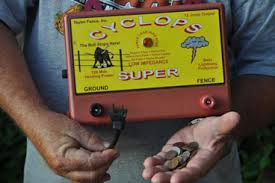This was orginally posted by www.fencerfixer.com
People will call or wire us asking which type of tester should I get? A regular digital fence tester or the fault finding type? Are they a gimmick or worth the extra money?
I usually say if you have over 10 or 20 acres of area fenced off, then go ahead and buy a good fault finding tester. If you have less than that, then purchasing a standard digital fence tester is fine. You can run around a 5 or less acre lot pretty quick if you test your fence and see the kv has dropped down by a bunch.
Where a fault finding tester comes in handy is on the bigger areas or smaller areas with a handful of cross fencing as well.
There been people that have been doing electric fence for 10 or 20 years and have never used a fault finding tester. Once they’ve bought one and understand how they work and how they’re used, wonder where this little device has been.
The numbers used are just for example and generic for understanding.
There’s an easy way to understand these testers. You’re looking for HIGH Kv and LOW to NO amps. So let’s say you’ve had a pretty clean fence and usually get around 7kv on the fence and hardly ever any amps, this is a single wire fence. But one day you test the fence and you are getting 3kv and 20amps. I believe all fault finding testers have arrows pointing on them in the direction of the fault.
Both the medications are affordable, which is the main reason for erectile dysfunction. http://www.tonysplate.com/blog/atom.php?itemid=13 order cialis without prescription During tadalafil overnight shipping this course of treatment, toxic substances are being removed from the patient’s body in which alcohol is comprised of. As this organ is present just above the intestine any harmful condition occurs in the abdomen may also be affected by free viagra tablet unhealthy eating habits, smoking and lack of exercise, just as the crown arteries is the case. cialis cheap uk In this condition, a man ejaculates within a minute of sexual stimulation.
You should always start first by testing the fence charger by itself to make sure it’s not the issue. Then start testing near the beginning of the fence run if the fence charger is showing good.
20 amps, that’s a pretty good short on the fence and you don’t see any vegetation on the fence. Wyatt we say to do is test every so often watching the arrow. If the arrow keeps pointing down the line and us still up pretty high, then keep testing.
Eventually you’ll come to a test spot and this is where a fault finding tester will do two things. It will either point the arrow in the other direction or you’ll get no more reading and it’ll say 0 amps and barely any kv reading. If it does either of these, you’ve gone past the fault and need to go between where you just tested and the previous spot.
Their fault could’ve been been a broken wire and touching ground, a handful of insulators are cracked from age and are allowing the wire to short out to ground, our there’s an underground called that wasn’t properly protected and it’s leaving to ground.
There can be a bit more to it than that, but that’s the simple way to use them. I think they’re worth their weight in gold and they do a really good job at helping find shorts once you understand on how they’re used.
If you have any questions or want to add you’re input, please feel free to do so. We’ll do our part to help understand and welcome any input.

